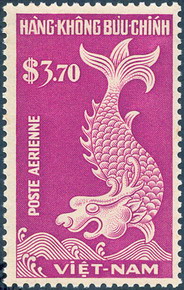
Of Genies, Carps and Education
(The legend of the three Kitchen Genies)
By QUY V. LY
The Vietnamese have a charming custom of venerating the “three kitchen genies,” particularly at Tet, their Lunar New Year. This practice dates back to ancient times. Long ago, according to legend, a mishap separated a very poor couple from one another. The wife tried desperately to find her husband, but in vain. Eventually she married another man.
The two grew old together, but then, one day, the woman’s first husband stood at her door. Full of remorse about her unfaithfulness, she committed suicide by jumping into the fire. Her first husband followed her into her into the flames, and so did the second.
God Almighty, called Ngoc Hoang or Jade Emperor in Vietnamese, was moved by the trio’s love and allowed them to live together forever. He elevated their souls to genies, charging them to supervise everybody’s household activities; the kitchen used to be the central place in the family home.
Ever since, on the 23rd day of the last month of the lunar year, the three genies are said to fly to Heaven to report to the Jade Emperor what they had observed in peoples’ kitchens. Based on their account, the Jade Emperor rewarded or punished every family according to its good or bad deeds.
As humorous Vietnamese lore has it, the genies will return from Heaven on the eve of Tet, the lunar New Year, to resume their duties and enjoy spring on earth. To please the three spirits, the Vietnamese prepare a meal of sweet steamed sticky rice, cone-shaped rice cookies and fruit; they also welcome the genies with flowers and a bucket of water containing one big live carp or three small carps as a means of transportation for the genies’ next heavenward journey.
Hoping that the genies will put in a good word for them during their subsequent meeting with the Jade Emperor, Vietnamese families will then release the carp into a nearby stream so as to show their kindheartedness. Still, they will feast on boiled fish later.
Why the carp? Well, here we have another legend – a legend about dragons, which are superior creatures because they bring rain to earth. At one time, so the story goes, Heaven ran out of dragons obliging the Jade Emperor to make new ones. So he organized a contest among aquatic animals. He gave them three gates as obstacles to jump over, the “three gates of rain.” Those who could leap over all three gates would be granted dragon status.
First came the tilapia, a freshwater species. It only cleared the first gate and was rewarded with a black dot on its side.
Then allegedly the catfish also passed the first level but hit its head against the second gate, which flattened its shape; the catfish was recompensed with dragon-like whiskers.
Next bounded the shrimp. It overcame two gates. Ever since, by the Jade Emperor’s grace, the shrimp looked like of a small dragon. Alas, in the end the shrimp stumbled and was crippled; its organs surged to its head, which is why shrimps now have a curved shape and move backwards, or so the Vietnamese quip.
But the carp prevailed. The carp succeeded in hopping over all three gates of rain, and so now it is a dragon.

"Cá hóa Long" (Carp becoming Dragon) stamp of the former Republic of Vietnam
For centuries, this myth has had great significance for the evolution of the Vietnamese social structure. As a way of selecting civil servants for its realm, the nation’s Imperial Court used to organize written examinations of its subjects ever since the Middle Ages. Anybody could participate in these tests, which opened the gates to three levels of accomplishment. The first was called Thi Huong, the second, Thi Hoi, and the third, Thi Dinh. In a sense, they might be compared to a high school degree, a baccalaureate and a doctorate.
Graduates of the highest test level (Thi Dinh) were in fact granted the title of Tien Si (doctor). They had their names engraved on stone tablets carried by carved stone tortoises, and these tablets were displayed at the “Temple of Literature” in Hue, the imperial capital of Vietnam.
The myth of the carp making the rank of dragon taught the Vietnamese that every citizen, even a peasant, could reach the highest civil rank by means of education. This is why the image of the carp becoming a dragon has been a very important motif of decoration in Vietnamese architecture and arts for centuries, and why hundreds of thousands of carp are dumped from buckets into fresh waters on every lunar New Years Day.